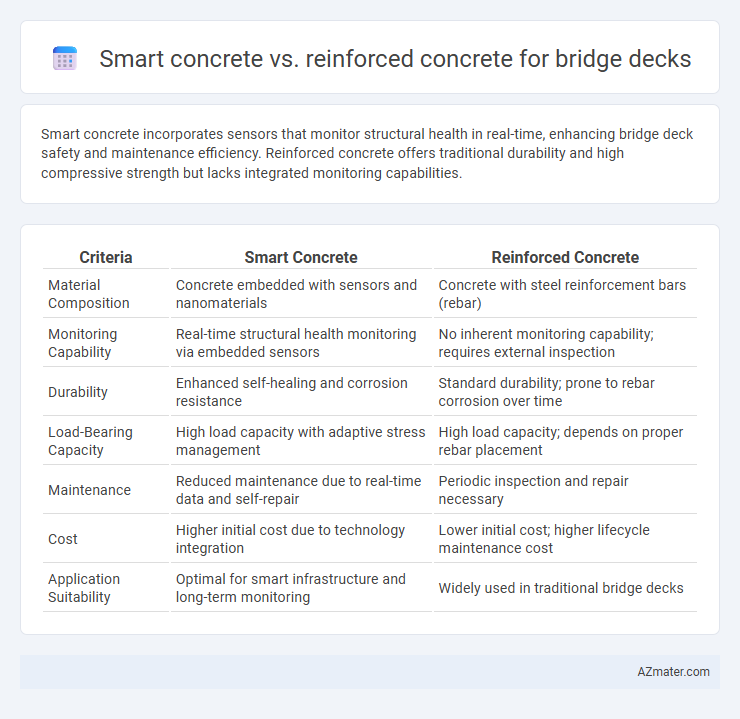Smart concrete incorporates sensors that monitor structural health in real-time, enhancing bridge deck safety and maintenance efficiency. Reinforced concrete offers traditional durability and high compressive strength but lacks integrated monitoring capabilities.
Table of Comparison
| Criteria | Smart Concrete | Reinforced Concrete |
|---|---|---|
| Material Composition | Concrete embedded with sensors and nanomaterials | Concrete with steel reinforcement bars (rebar) |
| Monitoring Capability | Real-time structural health monitoring via embedded sensors | No inherent monitoring capability; requires external inspection |
| Durability | Enhanced self-healing and corrosion resistance | Standard durability; prone to rebar corrosion over time |
| Load-Bearing Capacity | High load capacity with adaptive stress management | High load capacity; depends on proper rebar placement |
| Maintenance | Reduced maintenance due to real-time data and self-repair | Periodic inspection and repair necessary |
| Cost | Higher initial cost due to technology integration | Lower initial cost; higher lifecycle maintenance cost |
| Application Suitability | Optimal for smart infrastructure and long-term monitoring | Widely used in traditional bridge decks |
Introduction to Bridge Deck Materials
Smart concrete incorporates sensors and self-healing capabilities to enhance durability and monitor structural health in bridge decks, outperforming traditional reinforced concrete in real-time damage detection. Reinforced concrete utilizes steel rebars for tensile strength but lacks the adaptive features found in smart materials, leading to potential maintenance challenges over time. Integration of smart concrete advances bridge deck materials by reducing repair costs and extending service life through proactive performance management.
Overview of Reinforced Concrete
Reinforced concrete for bridge decks combines concrete's compressive strength with steel reinforcement's tensile capacity, creating a durable and cost-effective structural element. Its widespread use is attributed to high load-bearing capacity, resistance to environmental factors, and adaptability to various design requirements. Despite its advantages, challenges such as corrosion of steel reinforcement and maintenance needs have driven exploration into advanced materials like smart concrete.
What is Smart Concrete?
Smart concrete integrates sensors and conductive materials to monitor structural health in real-time, enhancing the durability and safety of bridge decks. Unlike reinforced concrete, which relies on steel reinforcements for strength, smart concrete detects stress, strain, and potential damage through embedded sensing technologies. This innovation enables proactive maintenance, reducing repair costs and extending the lifespan of bridge decks.
Key Differences Between Smart and Reinforced Concrete
Smart concrete integrates embedded sensors and self-healing materials that enable real-time monitoring and automatic crack repair, enhancing durability and reducing maintenance costs. Reinforced concrete relies on steel rebar for structural strength and crack resistance but lacks autonomous health monitoring or self-repair capabilities. The key difference lies in smart concrete's ability to provide continuous performance data and improve longevity through advanced materials, while traditional reinforced concrete depends solely on passive reinforcement techniques.
Durability and Longevity Comparison
Smart concrete incorporates self-sensing and self-healing properties that significantly enhance durability by detecting micro-cracks and initiating autonomous repair, reducing maintenance needs for bridge decks. Reinforced concrete relies on steel reinforcement that provides structural strength but remains susceptible to corrosion and cracking over time, potentially compromising longevity without regular intervention. Studies show that smart concrete's advanced materials extend the service life of bridge decks by minimizing deterioration, outperforming traditional reinforced concrete in long-term performance and resilience.
Structural Performance in Bridge Decks
Smart concrete enhances structural performance in bridge decks by integrating self-sensing and self-healing capabilities, reducing maintenance costs and extending service life. Reinforced concrete provides traditional strength and durability through embedded steel reinforcement but lacks intrinsic damage detection and repair features. The integration of smart materials in concrete improves crack resistance and load distribution, optimizing bridge deck resilience under dynamic loads.
Installation and Maintenance Considerations
Smart concrete for bridge decks offers simplified installation through self-sensing capabilities that reduce the need for embedded sensors and extensive wiring compared to reinforced concrete. Maintenance is enhanced by continuous structural health monitoring in smart concrete, enabling early detection of cracks and stress without manual inspections, unlike traditional reinforced concrete requiring periodic physical assessments. Reduced downtime and lower lifecycle costs result from the proactive maintenance facilitated by smart concrete technology.
Cost Analysis: Initial and Lifetime Expenses
Smart concrete offers potential cost savings in bridge deck construction through its self-sensing and self-healing properties, which can reduce maintenance frequency and extend service life compared to traditional reinforced concrete. Although the initial material cost of smart concrete is higher due to advanced additives and sensor integration, the overall lifetime expenses tend to be lower because of decreased repair needs and enhanced durability. Reinforced concrete, while less expensive upfront, typically incurs more significant maintenance and repair costs over the bridge's lifespan, making it less cost-efficient in long-term infrastructure projects.
Smart Features: Monitoring and Self-Healing Capabilities
Smart concrete for bridge decks integrates embedded sensors that enable real-time structural health monitoring, providing continuous data on stress, strain, and crack development. Its self-healing capabilities utilize microcapsules or bacterial agents that autonomously repair microcracks, enhancing durability and reducing maintenance costs. Reinforced concrete lacks these intelligent features, relying primarily on external inspections and manual repairs, which may lead to delayed detection and higher lifecycle expenses.
Future Trends in Bridge Deck Construction
Smart concrete integrates sensors to monitor structural health in real-time, offering predictive maintenance capabilities that enhance bridge deck durability and safety. Reinforced concrete remains widely used due to its cost-effectiveness and proven strength, but it lacks the advanced monitoring features essential for future infrastructure resilience. Emerging trends emphasize smart concrete's potential to revolutionize bridge deck construction through self-healing properties and IoT connectivity, driving longer service life and reduced maintenance costs.

Infographic: Smart concrete vs Reinforced concrete for Bridge deck
 azmater.com
azmater.com